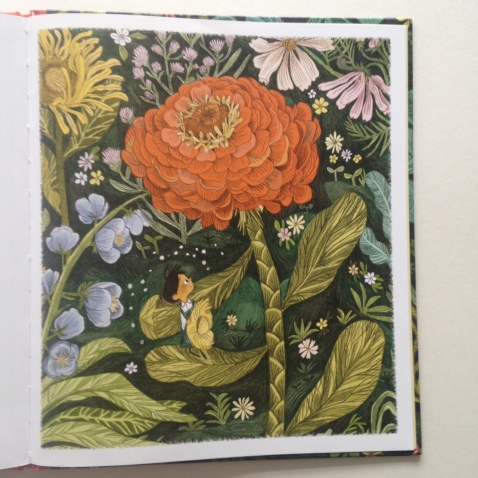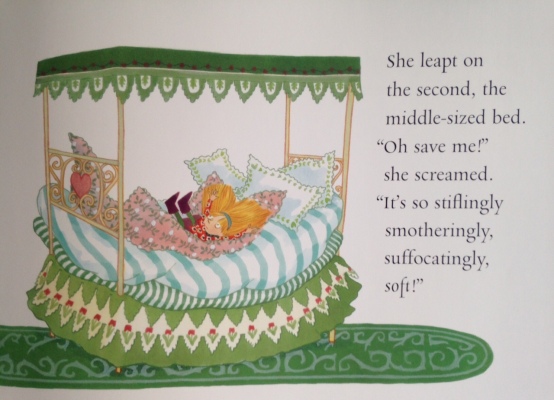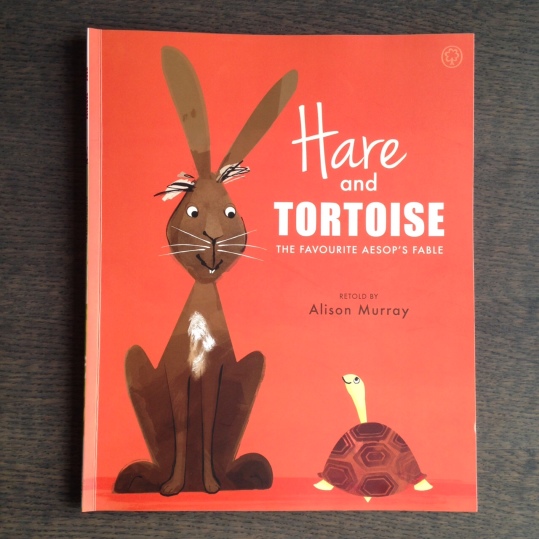The summer holidays are always an exciting part of a teacher’s year, and this year has been no exception. One of our first adventures was a road trip from Manchester , where we live, to Sligo on the west coast of Ireland to see one of my oldest friends get married (we have been friends since brownies!) We hadn’t done a major road trip as a family like this before but we thought the ferry would make a nice change from a plane plus we could pile the car up with all sorts of stuff rather than the rather poultry suitcase allowance we would get on a short flight. All good so far. But just how many books could we fit in a family car and how may would we need to get us through a week of hopping around B’n’Bs and hotels? Eventually I whittled it down to ten books and they had to be versatile enough to be read many times. You’ll be glad to know we made it through the holiday, had a great time and read all the books on the list several times so if you are doing something similar soon this might come in useful.
Tag: raisingareader
Learning about friendships
It is my unwavering belief that picture books help children to make sense of the world around them. If they are finding something difficult there is almost certainly a book that will help them out with it. Friendships can be one of the most difficult things for our little ones to navigate through. One day someone is your best friend, the next they don’t want to know you, the day after that they want to be your friend and it’s your turn to play it cool. Its all so tricky. There are gazillions of books about friendships and it’s a theme I plan to revisit many, many times but for today I thought I would champion some of the most interesting books I have recently discovered that show the reality of friendships and could help children to view friendship in a new way.
Back to School Books
If you, like me, have a little one going to nursery or school for the first time this September (blub), or if they are starting a new school, or if the summer holidays have been so long and lovely that your children have just forgotten all the fun things about school and seem a bit reluctant to go back then broaching the subject can be a tricky. Why not try one of these books to help them reflect on their feelings about school, start a converstaion about what they are looking forward to and give them the opportunity to share anything they might be nervous about.
Weekly pick: The Little Gardener
I really love instagram but there are times when I feel like I’m not really doing the books justice when I feature them on there, so I have decided that I’m going to try something new. Enter the new hashtag #bookhabitweeklypick.
It was tough picking which book woud go first but after a weekend where I finally felt like we were beginning to see some signs of spring I chose Emily Hughes’ beautiful ‘The Little Gardner’.

When I bought this book it was just a chance encounter. I didn’t flick through the pages, I hadn’t heard of it before or read anything by the author I just saw the cover and thought it looked interesting. I’m so glad I did. It has become a well-loved book in our house for both me and the little Magpie (my daughter, currently 3 and a half).

The text is simple, repetitive and gentle. It guides you through the story of a tiny gardner (perhaps some kind of fairy folk, although he doesn’t seem to possess any magical powers) and his friendly worm. Between them they try everything to keep the garden beautiful but it is just too much for them. After realising that the job is too big, the gardner wishes for help and then falls into a deep slumber for a month. When he awakes he finds that the universe has granted his wish (nearby children have cleared and planted while he slept). Where once it was overgrown and dangerous there are now flowering plants and new wildlife.

Part fairy tale, part fable, this story puts a great emphasis on the qualities of trying hard, perseverance, asking for help and most of all having hope. The text is used sparingly and all the emotions and extra details come from the intricately beautiful illustrations. Every time we look at them we find another hidden detail that we haven’t spotted before and this helps to keep the book exciting for little ones. The colour palette is more muted than many children’s books but it really adds to the atmosphere of the story and makes the garden transformation more visual and exciting at the end.

Emily Hughes is a really special talent and has a style which is instantly recognisable. If you haven’t given her books a try yet I would urge you to track them down and give them a whirl. They are truly magical and timeless and would easily earn their place on the most beautiful bookshelf.
If you have already enjoyed ‘The Little Gardner’ or would like to look out for more of her work, Emily Hughes has also published ‘Wild’ and has recently illustrated ‘A Brave Bear’ written by Sean Taylor.
Reading: a gift for life
A lot of the time, when people read with their children they do it to help them with their literacy skills and there is no doubt that works but to me reading is so much more than that. Reading benefits every part of who they are. Social skills, problem solving, patience, motivation, empathy, understanding of relationships can all be developed by simply picking up a book and diving in. And if you manage to help your child develop a love of reading then it is something that will be with them for their entire life, and that’s not something you can say about a lot of things. Being a child can be hard work but when they immerse themselves in a book they can really switch off. Not just the older children either. If my three year old is having a bad day a book can really break into her mood and it can be like pressing the reset button. This does not always work but is well worth a try! Below are just a few of my thoughts on what books can do for us and our children and not one of them is anything to with literacy. (Please remember that all of these also apply to adults reading books as well!)
Books can cleverly take something scary and make it funny.
Books can make you feel as though you are not alone.
Books can make you laugh when you want to cry.
Books can transport you to a million places when you can’t leave the house.
Books can make you see things from a different point of view.
Books can help you find an answer to a question noone else can answer.
Books can make you believe in magic.
Books can make you think for yourself.
Books can give you goals and dreams.
Books can turn an ordinary day into a magnificent adventure.
Books can be something different each time you read them.
Favourite Fairy Tales and Terrific Traditional Stories
With all the amazing choice in the picture book market these days, it is sometimes easy to forget the stories which have been around for hundreds of years. While some people believe that an over reliance on fairy tales might lead our children to develop some negative stereotypes, I’m sure that as part of a well balanced selection they can be taken at face value as the magical, exciting stories that they are. Once children get to school there is no doubt that they will be exposed to lots of them, the repetition and simple structures make the traditional story an important tool in a developing a child’s literacy. I think there is also a case to be made that many of these stories have become a part of our culture, in an age of technology where the latest fad may seem quite alien to other family members, a story like these can sweep aside age differences and give different generations a common narrative that they can enjoy together.
That being said, there are so many versions of each story that the qualiy can vary massively; some are whittled down to their bare bones or are produced without much thought or feeling while others are beautifully and thoughtfully written. It can be difficult to find a really good quality edition of some of the favourites we want to share with our children. Below I have selected books that I own which I feel really bring the traditional story to life in some way, be it through illustration, the use of language or giving a twist on the original story. I hope that you find something new here to look out for and if you know of a good one that’s been missed off the list please fill me in- I’m always on the look out for a new book!
Traditonal and Wonderful

Goldilocks and the Three Bears by Emma Chichester Clark
Those of you familiar with the Blue Kangaroo books will recognise this author/illustrator but I have to confess that this book is my absolute favourite of hers. The illustrations are so beautiful and rich with detail that they will straightaway catch your eye and capture your imagination. Emma has also put lots of thought into the story adding interesting vocabulary and extra little repeated phrases which makes it really enjoyable to read aloud, especially the dialogue she creates for Goldilocks. The text is on the long side but never boring and I’m sure it is a version which will have you revisiting it again and again. Oh and the endpapers have to have a special mention because they are just amazing!

The Gingerbread Boy by Paul Galdone
This book could not be more different from the Goldilocks above. It is illustrated in a very simple way whoch reminds me a bit of a woodcut. It uses mostly muted colours and has a rustic, countryside feel to it. However, it really does capture the spirit of the Gingerbread boy for me. Some people find it a bit more challenging to read as ‘Gingerbread Boy’ doesn’t fit into the rhyme quite as well but the children I have read it to (in school and at home) have never seemed to mind. Add to that some extra characters on the cast list eg a barn full of threshers and a field full of mowers, and there is plenty of discussion to be had about when this story is set and what those words actually mean. However, the stand out page for me is the one where the fox eats the the gingerbread boy and the illustration shows the gingerbread boy’s head peeping out from between his jaws as it’s being swallowed. I have never met a child who doesn’t love that combination of wicked and funny and it really gives the end of the story an extra bit of excitement.

The Gigantic Turnip by Aleksei Tolstoy and Niamh Sharkey
I’ve owned this book for a long time and I still get excited about looking at it because the illustrations are so good. The text is faithful to the traditional story and really repetetive which again reinforces the structure for the children listening to it and gives them plenty of opportunities for joining in and being actively involved in ‘reading’ it. The old man and the old woman are completely adorable which has you rooting for them from the beginning and the muted colours are used really cleverly to create a slightly dark atmsophere around the farm. I enjoy lots of the stories published by ‘Barefoot Books’ but this one has really stood the test of time for me and I’m confident it would do the same for any little bookworm.

Hare and Tortoise Retold by Alison Murray
I recently went on a book binge and this is new to my collection but I already love it. The illustrations flick between anatomical style pages labelling the features of each animal, maps and more traditional layouts which contribute towards telling the story. The text is gentle enough that you feel sorry for hare rather than totally disliking him and each animal has their own little refrain which gets the children joining in quickly. I also love the care she has taken over the verbs she has chosen to describe each character and can imagine it boosting vocabulary if read several times- tootle, race, chase, wander are just some of the examples. All in all a big thumbs up for this one, a lovely retelling of a classic that everyone should know.
Classics with a twist
These have been around for many years (as a child my sister and I were obsessed with Roald Dahl’s Revolting Rhymes and could recite many of them off by heart after a particularly bookish summer holiday) and are a fun way to mix things up and explore the stereotypes which can make us wary of this genre of books. Best read once your child has a solid understanding of the original, they are usually given a comic slant and are great fun for both the reather and the audience.

The Fairytale Hairdresser series by Abie Longstaff and Lauren Beard
My daughter chose this one and it has to be said it didn’t appeal to me straight away. Firstly, it is super girly with glittery pages and the theme which links all the books together is a hairdresser/ matchmaker from what I can tell (I have to admit I have only read two of them so far- the Rapunzel one and the Beauty and the Beast one) with quite a lot of mentioning of make overs, styling and such. However, the characters do seem to be more diverse than the usual stories. Also, it did emphasise the message of looking at the person inside rather than external appearances with the beast. Anyway, if you have a daughter of a certain age they will probably love this. Plus, as I said in a previous post, it’s important to let them make their own book choices as well as feeding them the ones we love and for my daughter this fitted that criteria perfectly.

The three little wolves and the big bad pig by Eugene Trivizas and Helen Oxenberry
This works equally well with a class full of children or as a bedtime story. It is quite wordy but so fun that even quite young children can keep going to the end without losing concentration. The big bad pig is just about as mean as a picture character can get, the houses the wolves build become more and more elaborate (think concrete, steel girders and all manner of equipment, appealing to those children who love a construction theme) and so does the pig’s method of getting in. While the beginning is quite dark, the ending is truly magical and actually a lot less hair raising than the original and carries a great message of thinking about things in different ways to solve problems. The illustrations are detailed and beautiful- it’s Helen Oxenberry so you can just imagine how perfect they are. It will also appeal to children who might think they have grown out of the traditional stories genre as the vocabulary is challenging and clever. Big thumbs up for this one!

Prince Cinders by Babette Cole
Of the books I’m featuring, this one is furthesy from its original form and it’s a real breath of fresh air. It features a wimpy Prince Cinders, a rubbish fairy that gets the spells wrong, a proposing princess and three hairy big brother princes who are eventually turned into house fairies and bare more than a passing resemblance to Freddy Mercury in the music video where he’s doing the hoovering. Children of all ages will enjoy this book but it’s probably best aimed at slightly older children so that they get the full force of the humour behind this book. A classic for a very good reason and perfect if you want to do something to balance out the stereotyping in the classic version.
I’d love to know what your favourite traditional story was as a child and whether you enjoy reading fairy tales to your children or intentionally steer them away. My final thought is from Albert Einstein:
“If you want your child to be intelligent, read them fairy tales. If you want them to be more intelligent, read them more fairy tales.”











